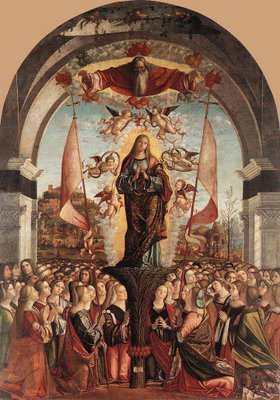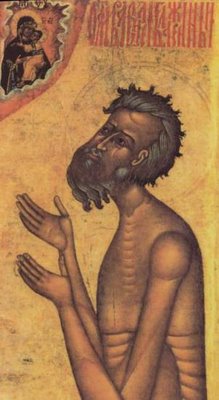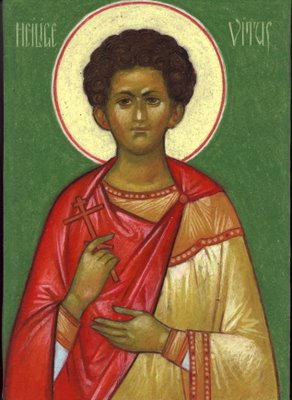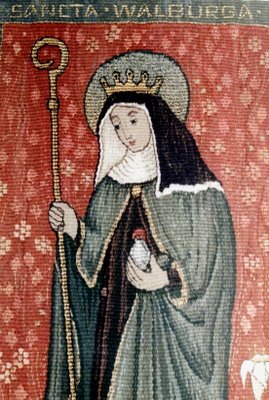 Frideswide was the daughter of King Didan. She was born in the mid 7th century. An early age, Frideswide was already rather spiritual, having been raised by a devout governess. After her mother's death, Frideswide persuaded her father to give her a large parcel of land at the gates of the city where she could build a church. Here she and twelve companions built a convent adjoining the church. The ladies were not, however, bound by the strict rules of the cloister, but only by their love of seclusion and chastity.
Frideswide was the daughter of King Didan. She was born in the mid 7th century. An early age, Frideswide was already rather spiritual, having been raised by a devout governess. After her mother's death, Frideswide persuaded her father to give her a large parcel of land at the gates of the city where she could build a church. Here she and twelve companions built a convent adjoining the church. The ladies were not, however, bound by the strict rules of the cloister, but only by their love of seclusion and chastity.
Frideswide's fame spread far and wide, and as a beautiful girl with plenty of money and vast tracts of land, she was seen as a rich prize. Aelfgar, the Earl of Leicester, decided to try and woo the lady and sent messengers asking for her hand in marriage. Though she was flattered, Frideswide would not give in because she had taken a vow of chastity. Aelfgar was furious at her refusal, and decided to take Frideswide by force. King Didan's spies, however, got wind of the plan and his daughter thought it best to flee to Oxford with two of her companions.
By the Thames, the three found a small boat tended by a white robed youth. Unknow to them, according to legend, the young man was an angel in disguise. He happily agreed to take them down the river to Abingdon. From here the ladies hid in the deep oak forest which covered much of Berkshire at that time. They then travelled many miles on foot to a place then called Bentona, now Yattendon. Here they discovered a small ivy-covered pig-sty. Frideswide made the sty into a small oratory for the three companions and they lived off the land for about three years, drinking from a well which appeared when Frideswide prayed for water.
In the meantime, Prince Aelfgar continued to search for Frideswide. He sent his emissaries all over the land looking for her. In desperation he gathered a large force of men and marched on Oxford. At the city gates, he threatened to burn the city down if Frideswide was not delivered to him. King Didan would not sacrifice his daughter, but the people of Oxford were frightened of loosing their homes. They opened the city gates to Aelfgar and revealed the princess's hiding place.
At a drunken party that night, Aelfgar declared he would take Frideswide for his pleasure, and that his men could have her too, whether she liked it or not. However, in the morning, after he became sober, he changed his mind and hoped to win her with a display of his persistent affection. He sent two messengers into the forest with gifts and songs of love. Frideswide received the ambassadors with quiet reverence, and listened to what they had to say. Her answer, however, was the same as before. The two messengers returned to Oxford, and as they entered the city gates to report to Aelfgar, they were both struck blind.
The prince was furious at the second rebuff. He jumped on his horse and rode off into the forest to confront Frideswide. She was going to be his wife whether she liked it or not. Near Frideswide's oratory, her two companions were out gathering berries when they heard Aelfgar's approach. They ran to their mistress to warn her. Frideswide's body, however, was weak and her spirit broken. It seemed she was cornered at last. She remembered Saints Catherine and Cecilia, who had also had to defend their virtue at the price of life, and she prayed to them for help. Just as she became within grasping distance of Prince Aelfgar, he was suddenly struck blind, just like his emissaries before him. Ever since, the superstition grew up that the same would happen to any monarch who entered the City of Oxford. Accordingly, the Kings of England stayed away until the reign of Henry III. Some said that all the ills of his reign were due to this. Perhaps, if the kings had known the Berkshire version: that the people of Oxford were St. Frideswide's betrayers, not her defenders, then they would have visited Oxford sooner
The prince fell to the ground, stumbling around in the mud and crying out for help. He pleaded forgiveness from Frideswide and swore to his repentance. He would leave her alone, if only he could see again. Having pity on this pathetic sight, Frideswide took Aelfgar by the hand and led him to her well. Here she bathed his eyes and prayed for his sight to be restored, and it was. Frideswide now decided to return to her nunnery at Oxford. She refused offers of a ride home, and travelled on foot.
On her way back through North Berkshire, she and her companions were accosted by a hideous leper. Her friends were repulsed, but when he asked her to kiss him, Frideswide overcame her natural revulsion. She made the sign of the cross and gave the man a sisterly kiss on the lips. At once his leprous skin fell away, to reveal his flesh to be as smooth once more. He was cured.
Frideswide lived happily at Oxford for many years. She eventually retired to quiet seclusion in Thornbury Wood where, at Binsey, she built a small chapel. She prayed for water once more, this time to St. Margaret, and a spring appeared to feed her for the rest of her life. She eventually died on 19th October 735 and was buried in her nunnery's church in Oxford. Many pilgrims visited the holy lady's grave and so many miracles occurred there that she was soon proclaimed a saint. She died in 735 of natural causes. The monastary she founded is now Christ Church College, University of Oxford, and the convent church became Oxford cathedral.
Hundreds of years later, in 1561 the bones of Saint Frideswide were dug up by an extremist Protestant reformer called Calfhill, who mixed them with the bones of a nun who had married a monk, and reburied it all in the cathedral with a new inscription 'Hic jacet religione cum superstitione' (Here lies religion with superstition). Ironically, by this act he preserved the saint's bones when so many other catholic relics were completely destroyed by Cromwell's enthusiasts.
Her feast day is October 19th
She is the patroness of Oxford England, University of Oxford, England
 Ursula is a British saint, and her feast day is October 21, though her feast was removed from the general calendar of saints in 1969.
Ursula is a British saint, and her feast day is October 21, though her feast was removed from the general calendar of saints in 1969.



